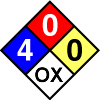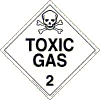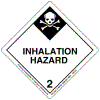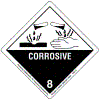Chlorine: Lung Damaging Agent
CAS #:
7782-50-5
RTECS #: FO2100000
UN #: 1017 (Guide 124)
Common Names:
- Molecular chlorine
Agent Characteristics
Greenish-yellow gas at room temperature; clear, amber-colored liquid under increased pressure or at temperatures below -30°F (-34°C).
Chlorine is a toxic gas with corrosive properties. It is widely used as bleach in the manufacture of paper and cloth and in manufacturing solvents, pesticides, synthetic rubber, and refrigerants. Chlorine has also been used as a chemical warfare choking agent. The lowest level at which humans can smell chlorine and notice its irritant properties generally provides sufficient warning of exposure; however, chronic exposure to chlorine causes adaptation of the sense of smell (olfactory fatigue) and tolerance to its irritant effects. Because of this, persons with a history of prolonged exposure lose the ability to identify when they are being exposed to chlorine. Chlorine is usually shipped in steel cylinders as a compressed liquefied gas.
- Indoor Air: Chlorine can be released into indoor air as a gas.
- Water: Chlorine can be used to contaminate water.
- Food: Food is an unlikely route of dissemination.
- Outdoor Air: Chlorine can be released into outdoor air as a gas.
- Agricultural: If chlorine is released as a gas, it is highly unlikely to contaminate agricultural products.
Inhalation is the main route of chlorine gas exposure. Contact with the escaping gas may cause frost bite.
Compressed liquid can cause frostbite and/or chemical burns to the eyes and skin. Significant skin absorption or ingestion is unlikely. Chlorine is a gas at room temperature, making ingestion an unlikely route of exposure.
Personal Protective Equipment
First Responders should use a NIOSH-certified Chemical, Biological, Radiological, Nuclear (CBRN) Self Contained Breathing Apparatus (SCBA) with a Level A protective suit when entering an area with an unknown contaminant or when entering an area where the concentration of the contaminant is unknown. Level A protection should be used until monitoring results confirm the contaminant and the concentration of the contaminant.
NOTE: Safe use of protective clothing and equipment requires specific skills developed through training and experience.
Select when the greatest level of skin, respiratory, and eye protection is required. This is the maximum protection for workers in danger of exposure to unknown chemical hazards or levels above the IDLH or greater than the AEGL-2.
- A NIOSH-certified CBRN full-face-piece SCBA operated in a pressure-demand mode or a pressure-demand supplied air hose respirator with an auxiliary escape bottle.
- A Totally-Encapsulating Chemical Protective (TECP) suit that provides protection against CBRN agents.
- Chemical-resistant gloves (outer).
- Chemical-resistant gloves (inner).
- Chemical-resistant boots with a steel toe and shank.
- Coveralls, long underwear, and a hard hat worn under the TECP suit are optional items.
Select when the highest level of respiratory protection is necessary but a lesser level of skin protection is required. This is the minimum protection for workers in danger of exposure to unknown chemical hazards or levels above the IDLH or greater than AEGL-2. It differs from Level A in that it incorporates a non-encapsulating, splash-protective, chemical-resistant splash suit that provides Level A protection against liquids but is not airtight.
- A NIOSH-certified CBRN full-face-piece SCBA operated in a pressure-demand mode or a pressure-demand supplied air hose respirator with an auxiliary escape bottle.
- A hooded chemical-resistant suit that provides protection against CBRN agents.
- Chemical-resistant gloves (outer).
- Chemical-resistant gloves (inner).
- Chemical-resistant boots with a steel toe and shank.
- Coveralls, long underwear, a hard hat worn under the chemical-resistant suit, and chemical-resistant disposable boot-covers worn over the chemical-resistant suit are optional items.
Select when the contaminant and concentration of the contaminant are known and the respiratory protection criteria factors for using Air Purifying Respirators (APR) or Powered Air Purifying Respirators (PAPR) are met. This level is appropriate when decontaminating patient/victims.
- A NIOSH-certified CBRN tight-fitting APR with a canister-type gas mask or CBRN PAPR for air levels greater than AEGL-2.
- A NIOSH-certified CBRN PAPR with a loose-fitting face-piece, hood, or helmet and a filter or a combination organic vapor, acid gas, and particulate cartridge/filter combination or a continuous flow respirator for air levels greater than AEGL-1.
- A hooded chemical-resistant suit that provides protection against CBRN agents.
- Chemical-resistant gloves (outer).
- Chemical-resistant gloves (inner).
- Chemical-resistant boots with a steel toe and shank.
- Escape mask, face shield, coveralls, long underwear, a hard hat worn under the chemical-resistant suit, and chemical-resistant disposable boot-covers worn over the chemical-resistant suit are optional items.
Select when the contaminant and concentration of the contaminant are known and the concentration is below the appropriate occupational exposure limit or less than AEGL-1 for the stated duration times.
- Limited to coveralls or other work clothes, boots, and gloves.
Emergency Response
- In water, chlorine is a strong acid, corrosive, and an oxidizer.
- In water, it forms hydrochloric acid (HCl) and hypochlorous acid (ClHO).
- Chlorine attacks plastic, rubber, coatings, and many metals in the presence of water.
- Chlorine reacts violently with bases, many organic compounds, ammonia, hydrogen, and many finely divided metals.
- Chlorine forms halides with all elements except helium, neon, and argon.
- Chlorine reacts explosively or forms explosive compounds with many common substances including, acetylene, ether, turpentine, ammonia, fuel gas, hydrogen, fluorine, and finely divided metals.
- Chlorine reacts with most combustibles posing a fire and explosion risk.
- Chlorine is not combustible.
- Containers may explode when heated.
- Ruptured cylinders may rocket.
- Chlorine is not combustible, but it enhances the combustion of other substances.
- Chlorine reacts violently with many organic compounds, ammonia, hydrogen, and finely divided metals, causing fire and explosion hazards.
- The agent may ignite combustibles (wood, paper, oil, clothing, etc.).
- Fire will produce irritating, corrosive, and/or toxic gases.
- For small fires, use water only; do not use dry chemical, carbon dioxide, or Halon™. Contain the fire and let it burn. If the fire must be fought, water spray or fog is recommended. Do not get water inside containers. Move containers from the fire area if it is possible to do so without risk to personnel. Damaged cylinders should be handled only by specialists.
- For fire involving tanks, fight the fire from maximum distance or use unmanned hose holders or monitor nozzles. Cool containers with flooding quantities of water until well after the fire is out. Do not direct water at the source of the leak or at safety devices; icing may occur. Withdraw immediately in case of rising sound from venting safety devices or discoloration of tanks. Always stay away from tanks engulfed in fire.
- For massive fire, use unmanned hose holders or monitor nozzles; if this is impossible, withdraw from the area and let the fire burn.
- Run-off from fire control may cause pollution.
- If the situation allows, control and properly dispose of run-off (effluent).
- If a tank, rail car, or tank truck is involved in a fire, isolate it for 0.5 mi (800 m) in all directions; also consider initial evacuation for 0.5 mi (800 m) in all directions.
- Small spills (involving the release of approximately 52.83 gallons (200 liters) or less)
- First isolate in all directions: 100 ft (30 m).
- Then protect persons downwind during the day: 0.2 mi (0.2 km).
- Then protect persons downwind during the night: 0.8 mi (1.2 km).
- Large spills (involving quantities greater than 52.83 gallons (200 liters))
- First isolate in all directions: 800 ft (240 m).
- Then protect persons downwind during the day: 1.5 mi (2.4 km).
- Then protect persons downwind during the night: 4.6 mi (7.4 km).
- Vapors are heavier than air. They will spread along the ground and collect and stay in poorly-ventilated, low-lying, or confined areas (e.g., sewers, basements, and tanks).
- Hazardous concentrations may develop quickly in enclosed, poorly-ventilated, or low-lying areas. Keep out of these areas. Stay upwind.
- Health: 4
- Flammability: 0
- Reactivity: 0
- Special: OX

- OSHA: ID101, ID126SGX
- NIOSH: 6011
- AIR MATRIX
EPA [1996]. SW-846 Method 0050: [PDF Format 188 KB] Isokinetic HCl/Cl2 emission sampling train. Washington, DC: U.S. Environmental Protection Agency.EPA [1996]. SW-846 Method 0051: [PDF Format 115 KB] Midget impinger HCl/Cl2 emission sampling train. Washington, DC: U.S. Environmental Protection Agency.EPA [1996]. SW-846 Method 9057: [PDF Format 44 KB] Determination of chloride from HCl/Cl2 emission sampling train (Methods 0050 and 0051) by anion chromatography. Washington, DC: U.S. Environmental Protection Agency.NIOSH [1994]. NMAN Method 6011: Chlorine and bromine. In: NIOSH manual of analytical methods. 4th ed. Cincinnati, OH: U.S. Department of Health and Human Services, Public Health Service, Centers for Disease Control and Prevention, National Institute for Occupational Safety and Health, DHHS (NIOSH) Publication No. 94-113.
OSHA [1990]. Chlorine; OSHA Method ID-101; fully validated. Salt Lake City, UT: U.S. Department of Labor, Occupational Safety and Health Administration, Organic Methods Evaluation Branch, OSHA Analytical Laboratory.
OSHA [1990]. Chlorine; OSHA Method ID-126SGX; partially validated. Salt Lake City, UT: U.S. Department of Labor, Occupational Safety and Health Administration, Organic Methods Evaluation Branch, OSHA Analytical Laboratory.
- OTHER
No references were identified for this sampling matrix for this agent. - SOIL MATRIX
Blackwell PA, Cave MR, Davis AE, Malik SA [1997]. Determination of chlorine and bromine in rocks by alkaline fusion with ion chromatography detection. J Chromatog A 770(1-2):93-98. - SURFACES
No references were identified for this sampling matrix for this agent. - WATER
EPA [1994]. SW-846 Method 9056: [PDF Format 217 KB] Determination of inorganic anions by ion chromatography. Washington, DC: U.S. Environmental Protection Agency.EPA [1996]. SW-846 Method 9212: [PDF Format 69 KB] Potentiometric determination of chloride in aqueous samples with ion-selective electrode. Washington, DC: U.S. Environmental Protection Agency.Greenburg AE, Trussell RR, Clesceri LS, eds. [1985]. Chlorine (Residual), Chapter 408. In: Standard methods for the examination of water and wastewater. 16th ed. Washington, DC: American Public Health Association.Russell RA [1983]. Accurate chlorine analysis. J Water Pollut Control Fed 55(11):1316.
Sullivan J, Douek M [1998]. Determination of inorganic chlorine species in kraft mill bleach effluents by ion chromatography. J Chromatog A 804(1-2):113-121.
Signs/Symptoms
Respiratory symptoms may be immediate or delayed for several hours or days after exposure to chlorine. Symptoms generally resolve within 6 hours after mild exposures, but may continue for several days after severe exposures. Deterioration may continue for several hours.
Chlorine gas is highly soluble in water; therefore, it is severely irritating on contact with moist tissues, such as the eyes, skin, nose, throat, and upper respiratory tract. At low concentrations, chlorine can cause eye and nose irritation, sore throat, and cough. At high exposure levels, irritation of the upper respiratory tract and accumulation of fluid in the lungs (pulmonary edema) contribute to a sensation of choking. Suffocation is the characteristic initial complaint of patient/victims exposed to chlorine. The majority of deaths occur within 24 hours and are due to respiratory failure.
- Mild to moderate: Burning discomfort, spasmodic blinking (blepharospasm) or involuntary closing of the eyelids, redness, inflammation of the eye’s membranes (conjunctivitis), and tear production (lacrimation).
- Severe: Corneal burns leading to cell death (necrosis) and tissue damage (ulceration).
- Exposure to escaping liquid chlorine may result in frostbite injury and/or chemical burns.
- Chlorine is present as a gas at room temperature, so ingestion is unlikely.
- Lung injury may progress over hours to days; lung collapse may occur.
- Mild to moderate: Rapid onset of eye, nose, and throat irritation; immediate coughing spasms and choking sensation; retching and vomiting (emesis) of stomach contents that may smell like chlorine; hoarseness or complete loss of voice (aphonia) often seen; high-pitched sounds caused by narrowing of the upper airway (stridor); severe chest discomfort; narrowing of the lower airways is an early and prominent effect of exposure; patient/victim describes the sensation of feeling smothered (suffocation); symptoms and signs of accumulation of fluid in the lung (pulmonary edema) may appear within 2 to 4 hours.
- Severe: Sudden death can occur due to critical narrowing of the upper airway; severe difficulty breathing or shortness of breath (dyspnea), so prominent that the patient/victim may refuse to move; copious secretions from nose and mouth (nasopharynx) and airways (tracheobronchial tree) (up to 1 L per hour); pulmonary edema may appear within 30 to 60 minutes.
- Mild to moderate: Irritation, burning pain, inflammation, and blisters (vesication).
- Severe: Severe chemical burns leading to cell death (necrosis) and tissue damage (ulceration).
- Exposure to liquefied (compressed) chlorine can result in frostbite injury and/or chemical burns.
Decontamination
The purpose of decontamination is to make an individual and/or their equipment safe by physically removing toxic substances quickly and effectively. Care should be taken during decontamination, because absorbed agent can be released from clothing and skin as a gas. Your Incident Commander will provide you with decontaminants specific for the agent released or the agent believed to have been released.
The following are recommendations to protect the first responders from the release area:
- Position the decontamination corridor upwind and uphill of the hot zone. The warm zone should include two decontamination corridors. One decontamination corridor is used to enter the warm zone and the other for exiting the warm zone into the cold zone. The decontamination zone for exiting should be upwind and uphill from the zone used to enter.
- Decontamination area workers should wear appropriate PPE. See the PPE section of this card for detailed information.
- A solution of detergent and water (which should have a pH value of at least 8 but should not exceed a pH value of 10.5) should be available for use in decontamination procedures. Soft brushes should be available to remove contamination from the PPE. Labeled, durable 6-mil polyethylene bags should be available for disposal of contaminated PPE.
The following methods can be used to decontaminate an individual:
- Decontamination of First Responder:
- Begin washing PPE of the first responder using soap and water solution and a soft brush. Always move in a downward motion (from head to toe). Make sure to get into all areas, especially folds in the clothing. Wash and rinse (using cold or warm water) until the contaminant is thoroughly removed.
- Remove PPE by rolling downward (from head to toe) and avoid pulling PPE off over the head. Remove the SCBA after other PPE has been removed.
- Place all PPE in labeled durable 6-mil polyethylene bags.
- Decontamination of Patient/Victim:
- Remove the patient/victim from the contaminated area and into the decontamination corridor.
- Remove all clothing (at least down to their undergarments) and place the clothing in a labeled durable 6-mil polyethylene bag.
- Thoroughly wash and rinse (using cold or warm water) the contaminated skin of the patient/victim using a soap and water solution. Be careful not to break the patient/victim’s skin during the decontamination process, and cover all open wounds.
- Cover the patient/victim to prevent shock and loss of body heat.
- Move the patient/victim to an area where emergency medical treatment can be provided.
First Aid
Initial treatment is primarily supportive. There is no post-exposure therapy specifically for chlorine inhalation.
There is no antidote for chlorine toxicity.
- Immediately remove the patient/victim from the source of exposure.
- Immediately decontaminate eyes with large amounts of tepid water for at least 15 minutes.
- Seek medical attention immediately.
- Immediately remove the patient/victim from the source of exposure.
- Seek medical attention immediately.
- Immediately remove the patient/victim from the source of exposure.
- Evaluate respiratory function and pulse.
- Ensure that the patient/victim has an unobstructed airway.
- If shortness of breath occurs or breathing is difficult (dyspnea), administer oxygen.
- Assist ventilation as required. Always use a barrier or bag-valve-mask device.
- If breathing has ceased (apnea), provide artificial respiration.
- Monitor for respiratory distress.
- Examine the moist lining of body passages and cavities (mucous membranes) for corrosive effects.
- Manage the airway aggressively in patient/victims with evidence of upper airway burns or fluid accumulation (edema).
- Monitor for and treat spasmodic narrowing of the large airways (bronchospasm) if it occurs.
- Seek medical attention immediately.
- Immediately remove the patient/victim from the source of exposure.
- See the Decontamination section for patient/victim decontamination procedures.
- Treat any chemical burns with standard burn therapy.
- In case of frostbite, protect the injured area from further injury until sustained rewarming can be initiated.
- Seek medical attention immediately.
Long-Term Implications
All patient/victims who have a suspected significant exposure or who have eye burns or serious skin burns should be observed in a hospital setting. Patient/victims suffering frostbite should be evaluated by a physician. An ophthalmologist should be immediately consulted for patient/victims who have injury to the cornea. Symptomatic patient/victims complaining of persistent difficulty breathing or shortness of breath (dyspnea), severe cough, or chest tightness should be admitted to the hospital and observed until symptom-free. Pulmonary injury may progress for several hours and accumulation of fluid in the lungs (pulmonary edema) may be delayed up to 24 hours.
For previously healthy individuals with an acute exposure to chlorine, pulmonary function usually returns to pre-exposure levels within 7 to 14 days. Individuals who survive a single, acute exposure usually have no long-term adverse health effects, although persistent effects have been reported. For example, exposure to chlorine may cause reactive airways dysfunction syndrome (RADS), a chemical irritant-induced type of asthma. For exposed individuals who have underlying cardiopulmonary disease or for those who suffer complications (for example, pneumonia) during therapy, the risk for developing chronic airway inflammation is increased.
Chlorine is not classifiable for carcinogenic effects. Data about developmental toxicity and reproductive toxicity are inconclusive. Chronic exposure to chlorine, usually in the workplace, may cause erosion of the teeth. Multiple exposures to chlorine have produced flu-like symptoms and a high risk of developing reactive airways dysfunction syndrome (RADS). Chlorine exposure may result in chronic inflammation of the large airways (bronchitis).
On-Site Fatalities
- Consult with the Incident Commander regarding the agent dispersed, dissemination method, level of PPE required, location, geographic complications (if any), and the approximate number of remains.
- Coordinate responsibilities and prepare to enter the scene as part of the evaluation team along with the FBI HazMat Technician, local law enforcement evidence technician, and other relevant personnel.
- Begin tracking remains using waterproof tags.
- Wear PPE until all remains are deemed free of contamination.
- Establish a preliminary (holding) morgue.
- Gather evidence, and place it in a clearly labeled impervious container. Hand any evidence over to the FBI.
- Remove and tag personal effects.
- Perform a thorough external evaluation and a preliminary identification check.
- See the Decontamination section for decontamination procedures.
- Decontaminate remains before they are removed from the incident site.
Occupational Exposure Limits
- NIOSH REL:
- Ceiling (15-minute): 0.5 ppm (1.45 mg/m3)
- OSHA PEL:
- Ceiling: 1 ppm (3 mg/m3)
- ACGIH TLV:
- TWA: 0.5 ppm (1.5 mg/m3)
- STEL: 1 ppm (2.9 mg/m3)
- NIOSH IDLH: 10 ppm
- DOE TEEL:
- TEEL-0: 1.45 mg/m3
- TEEL-1: 1.45 mg/m3
- TEEL-2: 6 mg/m3
- TEEL-3: 58 mg/m3
- AIHA ERPG:
- ERPG-1: 1 ppm
- ERPG-2: 3 ppm
- ERPG-3: 20 ppm
Acute Exposure Guidelines
| 10 min | 30 min | 60 min | 4 hr | 8 hr | |
|---|---|---|---|---|---|
| AEGL 1 (discomfort, non-disabling) – ppm |
0.50 ppm | 0.50 ppm | 0.50 ppm | 0.50 ppm | 0.50 ppm |
| AEGL 2 (irreversible or other serious, long-lasting effects or impaired ability to escape) – ppm |
2.8 ppm | 2.8 ppm | 2.0 ppm | 1.0 ppm | 0.71 ppm |
| AEGL 3 (life-threatening effects or death) – ppm |
50 ppm | 28 ppm | 20 ppm | 10 ppm | 7.1 ppm |
Decontamination (Environment and Equipment)
The following methods can be used to decontaminate the environment/spillage disposal:
- Do not touch or walk through the spilled agent if at all possible. However, if you must, personnel should wear the appropriate PPE during environmental decontamination. See the PPE section of this card for detailed information.
- Keep combustibles (e.g., wood, paper, and oil) away from the spilled agent. Use water spray to reduce vapors or divert vapor cloud drift. Avoid allowing water runoff to contact the spilled agent.
- Do not direct water at the spill or the source of the leak.
- Stop the leak if it is possible to do so without risk to personnel, and turn leaking containers so that gas rather than liquid escapes.
- Prevent entry into waterways, sewers, basements, or confined areas.
- Isolate the area until gas has dispersed.
- Ventilate the area.
Agents can seep into the crevices of equipment making it dangerous to handle. The following methods can be used to decontaminate equipment:
- Not established/determined
Agent Properties
- Chemical Formula:
Cl2 - Aqueous solubility:
Soluble - Boiling Point:
-29.3°F (-34.05°C) - Density:
Gas: 2.48 (air = 1)
Liquid: 1.4085 at 68°F (20°C), 6.864 atm
Liquid: 1.5649 at -31°F (-35°C), 0.9949 atm - Flammability:
Chlorine is not flammable, but it reacts explosively or forms explosive compounds with many common substances. - Flashpoint:
Chlorine is not combustible, but it enhances combustion of other substances.
- Ionization potential:
11.48 eV
- Log Kbenzene-water:
Not established/determined - Log Kow (estimated):
0.85 - Melting Point:
-150°F (-101°C) - Molecular Mass:
70.9
- Soluble In:
Bases, chlorides, and alcohols
- Specific Gravity:
1.56 - Vapor Pressure:
5,168 mm Hg at 68°F (20°C) - Volatility:
Not applicable, because chlorine is a gas above its boiling point of 93.2°F (34°C).
Hazardous Materials Warning Labels/Placards
- Shipping Name:
Chlorine - Identification Number:
1017 (Guide 124) - Hazardous Class or Division:
2.3 - Subsidiary Hazardous Class or Division:
8 - Label:
Poison, Inhalation Hazard
Corrosive
Toxic Gas - Placard Image:

Trade Names and Other Synonyms
- Bertholite
- Chloor (Dutch)
- Chlor (German)
- Chlore (French)
- Chlorine gas
- Chlorine mol.
- Cloro (Italian, Spanish)
- Dichlorine
In the event of a poison emergency, call the poison center immediately at 1-800-222-1222. If the person who is poisoned cannot wake up, has a hard time breathing, or has convulsions, call 911 emergency services.
For information on who to contact in an emergency, see the CDC website at emergency.cdc.gov or call the CDC public response hotline at (888) 246-2675 (English), (888) 246-2857 (Español), or (866) 874-2646 (TTY).
The user should verify compliance of the cards with the relevant STATE or TERRITORY legislation before use. NIOSH, CDC 2003.


